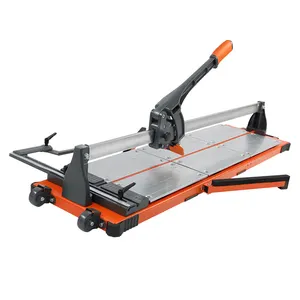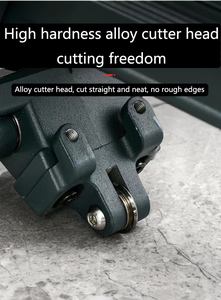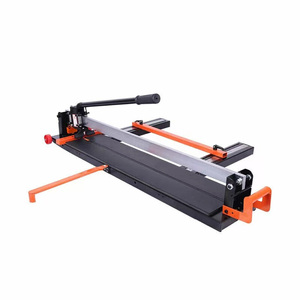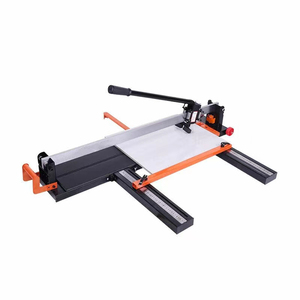
All categories
Featured selections
Trade Assurance
Buyer Central
Help Center
Get the app
Become a supplier

(1247 products available)













































Tile cutters are essential for floor and wall tiling work, offering clean and accurate cuts, which are vital in achieving desired tile layouts. Manual tile cutters are best for small projects involving straightforward cuts, while electric ones offer more power and precision for larger jobs. Below are the types of tile cutters based on functionality and operation.
With a width of 900mm, manual tile cutters are suitable for professionals and contractors who handle moderate projects. These cutters comprise a straight line marked on a working bed upon which the tile is placed, and to cut the tile, a scoring wheel is drawn across the line indicating the bed of the cutter. After the score, the operator would break the tile along the score line previously made. While manual tile cutters are affordable, they are also portable and suitable, especially for straight cuts. They do not need power, thus can serve where electricity is not available. However, they are adequate for cutting only glazed tiles and doing simple tasks and may not suit complex cutting operations.
Also referred to as tile saws, electric tile cutters are powered tools intended to make accurate and elaborate tile cuts. An electric tile cutter employs a diamond blade to cut the tile while providing more consistent results and better accuracy. They are suitable for large projects or when cutting hard materials like granite or porcelain tiles. Even though electric cutters are more expensive and demand power or battery reserves, they are much more effective. They do well in inner corners, outer corners, and notches, and they do well in curved edges as well.
Wet tile cutters look similar to electric tile cutters, except for the fact that they use water to reduce tile overheating. The tile to be cut is held fix while a diamond blade rotates, cutting into the tile. A water stream over the blade and tile keeps the blade cool. Wet tile cutters are ideal when cutting hard and thick tiles like granite and porcelain. They help reduce tile chipping and cracking because of the cooling effect. They are large and harder to handle. They are tremendously effective, though, so they are best suited for cut corners, notches, inner edges, outer edges, and straight lines.
Rail tile cutters work best for large tiles. They work something like a combination of manual and electric cutters. These consist of a straight rail line on which a movable scoring tool slides, focused on making straight cuts while breaking that tile easily. Rail tile cutters are best when straight cuts are needed, rather than complex angled or notches. They are simple to use and provide more accuracy than manual cutters. They are easier to set up for complex operations and can suffice for long tile pieces.
The construction industry has many applications with the 900mm tile cutter, especially in floorings. It provides clean and accurate cuts irrespective of the tile size, hence enhancing efficiency and productivity. The wet and electric variations are also designed to manage heavy workloads. They are durable for ongoing usage and remain a cost-effective solution for contractors handling large numbers of tiles in their installations.
Interior design professionals and those engaging in renovations rely on tile cutters to offer diverse design implementation capabilities. The 900mm size allows the users to cut larger tiles that are on trend today, such as expansive designs and geometric patterns. Since large tiles can offer fewer grout lines, a tile cutter will enable designers to execute desired aesthetic effects while maintaining a clean and precision cut. One of the great things is that interior designers can o0perate a rail tile cutter, which is easy to transport when doing feasibility studies, and electric cutters are used when efficiency is required for installation work.
Cutting tools used for tiling are also applied in tile distribution businesses. The tile retailers and wholesalers use the tile cutters in large batches for the custom sizes preferred by their customers. 900mm tile cutters help distributors meet niche market demands and enforce quick modifications during retail sales. They are also portable, enabling the users to easily and quickly modify tiles for smaller projects.
Plywood and laminated particle boards are commonly used in making cabinets and other wooden furniture. With the emergence of new types of engineered wood, these materials are fast losing their popularity. The furniture industry employs tile cutters to integrate tile-faced pieces, like tiled tabletops.
Diamond blade
A diamond blade is a type of blade used in cutting tool machines, and it includes small bits of diamond embedded in the matrix for cutting edge material. Diamond blades are used to cut concrete, asphalt, tiles, stones, and other extremely hard materials, making them perfect for tiling work. While tile cutter blades can come in diverse sizes for accomplishing different-sized tasks, the best diamond blade for tile cutters is 900mm, considering how large the tile is that it can cut. A diamond blade is suitable for cutting large tiles, and it also retains its sharpness for an extended period so that clean and precise cuts will be maintained.
Sliding rails
Sliding rails are mostly used in rail tile cutters, which provide support and guidance for tiles during the cutting process. Tile lays on the rail and slides through the cutter marked line for cutting. It allows make straight cuts while ensuring accuracy. For precise cutting, rail should be well maintained and free from debris and other particles.
Cutting guide
Cutting guides are often applied in manual tile cutters, whereby a movable handle is scorning tile, and cutting guide assists in setting the direction of the cut. This guide is significant in making angled or straight cuts, making it possible to achieve increased precision when cutting tiles. Tile setters can adjust the cutting guide to the desirable angle or straight line, making the cutting process easier.
Proper installation and usage of tile cutters are very important for clean cuts and tile, for safety, and for making the cutter last longer.
Tile cutter repair and maintenance ensure that the tool serves for long and always cuts tiles in good condition.
The blade plays a major role in tile cutting during the operation. It is always important to use high-quality material blades. For tiles, diamond blades are the most suitable because they are harder than steel and, therefore, can maintain sharpness for an extended period. Blades are also chosen according to the type of tiles; for instance, a continuous rim blade is preferable for glass and porcelain tiles because it avoids chipping. Segmented blades are ideal for cutting harder tiles like granite since it removes more material and minimizes heat.
The cutting surface, particularly in rail tile cutters, must be clean and free from debris to ensure accurate cuts. It is best to check for any tile particles or other substances that may interfere with the cutting process before placing a new tile. Any object or material on the surface will affect the tile during cutting and may cause the cutter to be damaged. A clean surface is vital for achieving smooth cuts and maintaining the condition of both the blade and the cutter over time.
While tile cutters have various features that enhance safety, using personal protective equipment, or PPE, is very important. Safety goggles are mandatory to shield the eyes from dangerous tile fragments. Gloves minimize hand injury. Masks used to cover the nose and mouth prevent entry of fine dust into the respiratory tract. Hearing protection is important when operating electric and wet tile cutters because they generate noise. By following PPE, tile contractors avoid potential injuries and keep focusing on providing quality tile jobs.
Any tile cutter requires frequent probes related to its parts to offer additional safety. This inquiry focuses primarily on potential hazards, such as blade wear, electrical connection damage, or excessive rail wear. The machine's moving parts and manual, too, may need to be replaced due to wear and tear. By performing inspection and maintenance on the tile cutters, their lifespan can be increased, and the chances of injuries and accidents can be reduced. It is important to note that if a tile cutter is found damaged, it is not recommended to use it until it gets repaired.
A1: Selection of tile cutter will depend on the nature of the project at hand. Manual tile cutter may suffice for small jobs requiring simple cuts, but electric or wet tile cutters are more appropriate for larger projects or harder tile materials.
A2: Yes, it is possible to cut large tiles using an angle grinder, provided an appropriate diamond blade suitable for tile. Angle grinders provide flexibility and are ideal for cutting corners and intricate designs, although they may not deliver straight cuts compared to dedicated tile cutters.
A3: Using a sharp diamond blade suitable for the material, ensuring the tile is well supported, using a steady, even pressure, and not rushing the cut will help prevent breaking.
A4: The main purpose of the orbital sander is to give a flat surface finish to an object by abrasion, while a tile cutter, which is a cutting tool, is used to give the object a certain shape or size.
A5: A tile cutter is meant for tiles only; they cannot cut stones or stone slabs. A stone cutter or rock cutter should be used for stone slabs.